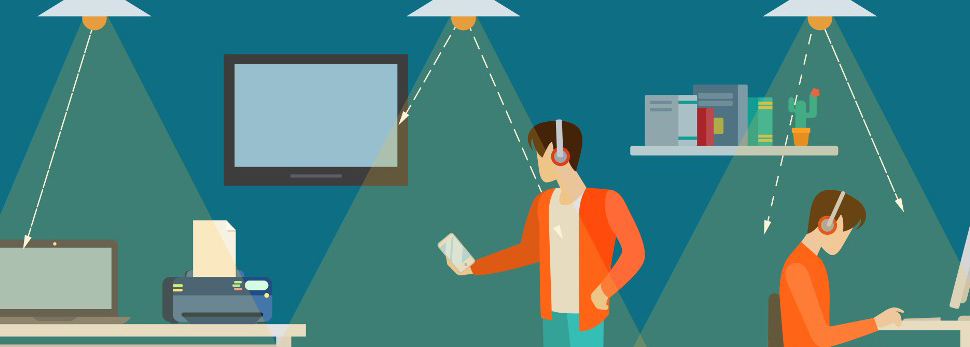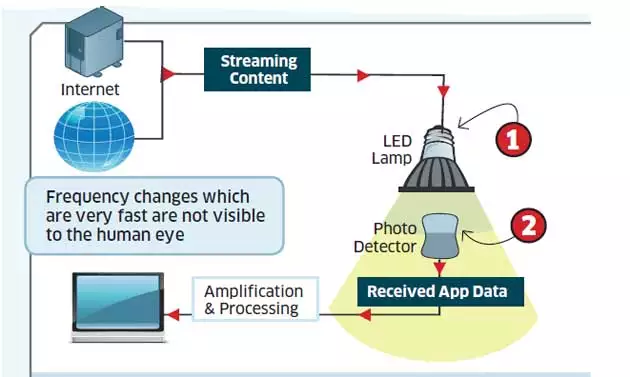What is Li-Fi
Li-Fi is the transmission of wireless data by using visible light as a medium of communication. Also known as Light Fidelity, Li-Fi uses subtle fluctuations in LED light to transmit data from the transmitter to the receiver. To encode the data, the LED light is switched on and off at an imperceptible speed creating slight fluctuations that is invisible to the naked eye. These fluctuations generate binary codes that are transmitted to the receiver which decodes the data back into digital form.
There are two main components of a Li-Fi system:
- A transmitter that is often a high brightness LED light
- a receiver which is often a photodiode fitted into the receiver to convert light back into digital data.
Li-fi technology is much faster as compared to the traditional Wi-Fi technology. It is capable of transmitting data up to 100 Mbps. In some cases, by using parallel transmission, more than 10 Gbps of data can also be transmitted. This means that you can download high definition 1080p videos in mere seconds.

Li-Fi is a powerful technology that has the potential to transform our lives by allowing us to transmit data from simple LED bulbs that are already being used in most homes and offices. All homes, offices and other facilities are equipped with lighting. Think about how much energy we can transmit if each of those bulbs is upgraded to LED bulbs fit to be used for Light Fidelity. This could translate into a much bigger coverage than the coverage capacity of traditional Wi-Fi modems.
Brief History
Li-Fi technology was first introduced by a German Professor, Physicist and communications technology innovator, Herald Haas, at a TED talk in July 2011. In his talk, Herald demonstrated how energy can be transmitted from a light bulb by inducing subtle changes in the amplitude of the light bulb in such high speed that they are not visible to the human eye. Herald demonstrated Li-Fi to the audience by the playing a high-definition video of a flower that was solely transmitted using a led table lamp with an LED bulb.
Herald helped start a company pure Li-Fi to commercialize Li-Fi products and integrate them with the existing LED lighting systems.
In October 2011, a number of industry groups and companies joined hands to form the Li-Fi consortium with an aim to promote the use of high speed optical wireless transmission. Since its first public demonstration in 2011, the Li-Fi technology has evolved significantly over time. By August 2014, data transmission exceeding 1.4Gbps was demonstrated by using Li-Fi technology.
Today, Li-Fi has been deployed in more than 20 countries. It continues to grow as more and more companies and industries are exploring what Li-Fi can do in their businesses.
How it is different from Wi-Fi
The main difference between Wi-Fi and Li-Fi is based on the medium used to transmit data. Wi-Fi transmits data wirelessly over modems by using radio waves. In contrast, Li-Fi uses visible light to transmit and receive data over LED light bulbs.

Pros of LiFi
Li-Fi technology offers many advantages over the traditional Wi-Fi. Some of the major advantages of Li-Fi have been described below:
High-Speed
Data transmission over Li-Fi is a hundred times faster than data transmission over Wi-Fi. At this speed, a high-definition video can be downloaded in mere seconds. Li-Fi can deliver speeds as high as 1Gpbs.
Capacity
Wi-Fi is being used in almost all residential and commercial areas. Due to this, radio frequency spectrum occupancy is increasing day by day limiting the capacity of data that can be transmitted over radio waves. At the same time, usage of wireless data is increasing exponentially year by year.
Li-Fi can be used to cater to the growing demand for wireless data as it offers a much higher capacity for data transmission as compared to traditional Wi-Fi. The size of the visible light spectrum is 10,000 times greater than the radio waves spectrum used in conventional Wi-Fi data transmission. Light bulbs exist everywhere and so the infrastructure is already there for adopting Li-Fi on a large scale.
Security
Radio waves can penetrate through walls, and they can be intercepted by agents outside your network compromising the security of your data. In contrast, light cannot penetrate through walls. It is confined to the room that it has been created in. Therefore, no one outside the room can intercept the data being transmitted over li-fi.
Efficiency
Because most homes and offices already use light, Data transmitted over Li-Fi is far more energy efficient as compared to data transmission over radio waves.
No Interference
Li-Fi is also free from problems such as neighbouring network interference, radio interference or interference generated due to sensitive electronics making it much more energy efficient.
Cons of LiFi
Reliance on Light Sources
With Li-Fi, light must be available 24/7. You cannot switch off the light; you can only dim it if you want uninterrupted transmission of data. This seriously limits the locations and situations in which Li-Fi may be used.
Limited Range
This range for Li-Fi is limited as the light signal cannot penetrate across walls. While this makes Li-Fi secure, the limited range can be a nuisance for some people.
Applications of Lifi
The applications of Li-Fi are limitless. It is a technology that will extend the capabilities of Wi-Fi communication even beyond our imagination. Where there is an LED light, there can be data. Some of the most common applications of Li-Fi are summarized below:
The Military
Unlike Wi-Fi, Li-Fi is confined to a small range. As light does not penetrate walls, data transmitted over Li-Fi can be limited to a small area such as a tent. This makes Li-Fi great for use by the military even in remote locations as the data can’t be intercepted by outside hackers. Moreover, no complex wiring infrastructure is needed for li-fi, where there is light, there is li-fi. BT has already begun testing Li-Fi for military bases.
Traffic Lights
Li-Fi can be used to provide drivers with traffic and weather updates as they wait at the traffic lights. This also eliminates the problem of getting critical traffic updates to drivers who are already on the road.
Underwater Communications
Traditional Wi-Fi cannot be used underwater because radio waves get absorbed by the water. Li-Fi, on the other hand, uses light for data transmission. Visible light can penetrate deep into the water and therefore it can be used for underwater communication potentially changing the way underwater vehicles and divers communicate with each other.
Augmented Reality
Augmented reality is being used in institutions such as museums to enhance the customer experience. However, like many other services that are dependent upon Wi-Fi, the experience can be slow and sluggish as the number of people connected on the network increases.
Li-Fi can easily solve this problem by providing each exhibit with its own data stream using a Led Powered light bulb. Moreover, Li-Fi enabled lighting can also provide localized information within that light.
Li-Fi will enable the customers to not only enjoy an uninterrupted AR experience at the museum, but It will also empower them to download information about that exhibit using the light that illuminates the exhibit.
Dense Urban Environments
Most urban environments are completely illuminated by artificial light. This existing infrastructure of lights can be used to provide high-speed data access to users at all times. For instance, users waiting on a hotel corridor can have access to high-speed downloads facilitated by Li-Fi. Not only that, all the rooms in the hotel can get localized Li-Fi access giving them no interference and extremely high-speed data access.
Safety Environment
The use of cell-phones is prohibited in places having high-risk explosive environments. Transmission of data using Li-Fi will simplify data encryption and configuration in such environments. Using Li-Fi new modes of securing such environments from potential hazards may also be developed. The possibilities are endless.
Li-Fi is a powerful technology that can have revolutionary implications in the world of IT. Many companies have already started using Li-Fi to provide ground-breaking connectivity solutions to not only their employees but also their customers. Li-Fi is a secure, faster and safer alternative to wireless data transmission using radio-waves. It is already being used in more than 20 countries across the globe. The number is expected to grow significantly as more and more applications of Li-Fi are discovered and developed.

2 Comments
Content is great! I hope Lifi will become part of life soon.
You can only recieve data with LI FI so internet access is not possible using LI Fi only so WI Fi will still be required